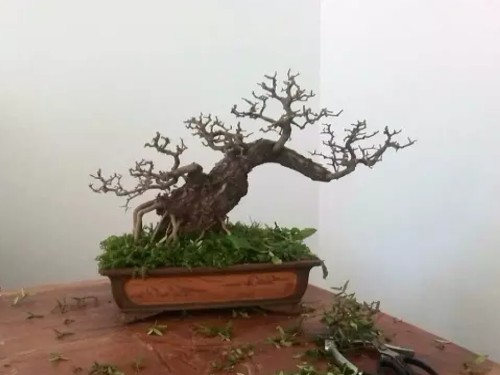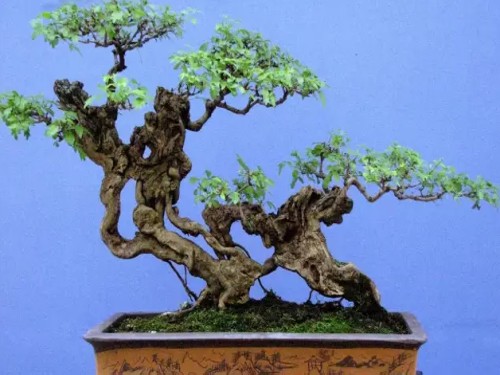Potting technique of bonsai with tree stump
Tree stump bonsai is referred to as stump bonsai. Woody plants are often used as production materials, and plants with graceful posture, short plants, compact leaves, long life, pruning resistance, strong resistance and easy modeling are selected to restrain their growth without violating the tree growth habits, picking leaves and coring, and carry out modeling processing. In the process of cultivating this kind of bonsai, the producer can process it into a variety of artistic shapes, such as intertwined or vigorous, straight and straight, according to his own intention. Graceful trees can become perfect bonsai works of art only if they are matched with bonsai bowls of moderate size, appropriate depth, matching style, coordinated color and suitable texture.
When choosing a pot, you should first pay attention to the right size. If the basin is too large, it will make the basin appear empty, the trees appear small, and at the same time, if the basin is large and full of soil, it will store too much water, cause trees to grow too long, affect the shape, and cause rotten roots; if the basin is too small, it will make the bonsai look top-heavy and lack a sense of stability. and it is easy to cause insufficient water and nutrients, affecting the growth of trees. Generally speaking, for sturdy trees, the pot surface used for isolated planting must be smaller than the crown range, and the pot length must be greater than the height of the trunk; co-planting should be slightly larger to show a certain space environment. In addition, when using a shallow basin, the basin mouth surface would rather be large than small; when using a deep basin, it would rather be small than big.

The depth of the basin has a great influence on the modeling of bonsai, and also has a certain influence on the growth of plants. Using the basin too deep will make the trees in the basin appear low and not conducive to the growth of dry plants; if the basin is too shallow, it will make the trunk thicker and taller trees have a sense of instability, and it is difficult to plant, which is not conducive to wet and flower-fruit trees. Generally speaking, the shallowest basin should be used in the co-planting type, the shallower basin should be used in the straight dry type, the basin with moderate depth should be used in the oblique dry type, horizontal dry type and curved dry type, and the deepest thousand-barrel basin should be used in the cliff type, but the medium-deep basin is sometimes used in the large cliff type. to show the length of drooping branches. In addition, for regular bonsai trees, it is customary to use deeper pots, while natural bonsai trees, especially those with accessories in the pots, cannot be deep.
After the selection of the pot, the bonsai will be put on the pot. Here are the techniques of the bonsai.
The main results are as follows: 1. After the stumps excavated in the mountain have been planted in the cultivation basin for a year and a half, the cuttings or seedlings can be planted directly in the ornamental basin after they are cultivated and shaped in the field. First of all, the pots should be selected according to the size and production form of the stump, that is, the stump and the basin should match properly. You can put the tree makeup on the selected pots, measure and compare it, and then put it on the basin after thinking it is appropriate.
Most of the materials used as stump bonsai are small branches and leaves, potted plants are easy to survive, slow growth, long life, strange roots and stems, especially those with gorgeous flowers and fruits. At present, there are about 160 species of landscape trees that have been used as stumps. In addition to artificial reproduction, the stumps of old trunks that have been cut down for many years are often extracted from mountain and forest fields. Tree stump bonsai can be summarized as straight dry, oblique dry, curved dry, lying dry, cliff, withered, even root, attached stone, jungle and other forms.
2, upper basin soil, generally use neutral soil bad, sex like acid tree god, can add a small amount of acid base fertilizer or acid old soil. The basin soil is required to be fertile, loose, rich in organic humus, good aggregate structure, permeable and breathable, can be used with rotten leaf soil, pond soil, vegetable garden soil, fire, and add rice bran ash, cake fertilizer, bone powder, mix well and serve as a basin.
The best cultivated soil is loose and permeable, good drainage and fat preservation. Bonsai production has pruning-based shaping method and wire or brown wire binding branches bent into a certain shape, and then carefully trimmed year by year and other methods, and have different local styles.
3. Before planting, cover the basin hole with broken tiles or broken pieces at the bottom of the basin. The shallow basin hole should be covered with a thin screen. The bottom of the deep basin is filled with coarse basin soil with good aggregate structure to facilitate drainage. When planting in a shallow pot, wire can be used to fasten the root and the bottom of the basin. Co-planted trees can be planted according to the tree phase, the roots of several trees are interspersed with brown wire or wire, and then the roots are tied into a body. So that it is not easy to fall.
4. When planting, determine the position of the tree makeup in the pot, pay attention to the tree potential and tidy up the roots. If the root is too long, cut it short and cut it down so that the new root can grow downward for viewing. The root of the flat layer is slightly exposed to the soil surface, and the root-lifting type should be exposed as required. When covering the soil, the bottom of the basin is thick, the basin is fine, and the natives on the basin are small and moderate. When covering the soil, it should be gradually put into the basin soil and compacted by hand. The basin edge soil should be slightly lower, and when watering, the water can penetrate to the bottom of the basin along the basin edge, and then pour water with spray pot or ladle with overflowing water, then place it in a semi-shady place for maintenance, and move to the position where the tree stump likes yang or half-yin a week later.
Time: 2019-06-03 Click:
- Prev

The principle of pot allocation of bonsai trees
There are many kinds of pots and bowls produced in our country, with ever-changing styles and rich colors. As far as texture is concerned, there are tile basin, pottery basin, glaze basin, porcelain basin, stone basin and so on, their respective properties and functions are different, of which pottery basin and glaze basin are more commonly used. Yixing sand pottery basin and Guangdong Foshan glazed pottery basin have a long history.
- Next

Conception of design of potted landscape
Bonsai trees to trees as the main body, due to different materials, usually divided into tree scenery and pile scenery two categories. Treescape is made of young trees and processed artistically, so it is often called childhood cultivation. In the tree bonsai creation, a pot can be called a masterpiece of bonsai, its various parts must be integrated, unified coordination
Related
- Fuxing push coffee new agricultural production and marketing class: lack of small-scale processing plants
- Jujube rice field leisure farm deep ploughing Yilan for five years to create a space for organic food and play
- Nongyu Farm-A trial of organic papaya for brave women with advanced technology
- Four points for attention in the prevention and control of diseases and insect pests of edible fungi
- How to add nutrient solution to Edible Fungi
- Is there any good way to control edible fungus mites?
- Open Inoculation Technology of Edible Fungi
- Is there any clever way to use fertilizer for edible fungus in winter?
- What agents are used to kill the pathogens of edible fungi in the mushroom shed?
- Rapid drying of Edible Fungi

